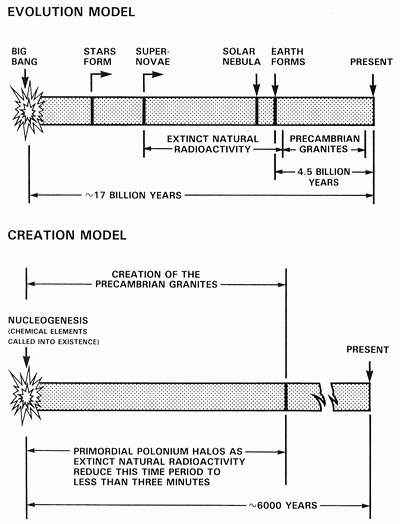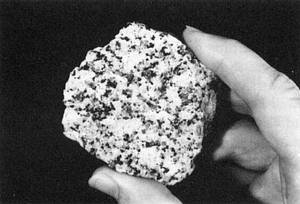Chapter 2: The Genesis Rocks
Primordial and Secondary Rocks
If most of evolutionary time had vanished, there had to be another framework of earth history. Using different
premises, could the Genesis account of creation and a worldwide flood provide such a framework? The basement
rocks of the continents, the Precambrian granites, would be classed among the primordial Genesis rocks of our
planet. And what about the vast rock formations that had been laid down by the action of water—those that
contain plant, animal, and marine fossils? Evolutionary theory held that it took hundreds of millions of years for all
these sedimentary rocks to accumulate and millions more for erosion to carve out scenic wonders such as the Grand
Canyon. But these conclusions were hinged on geological uniformitarianism. [p. 34] If that assumption
was incorrect, then I had to ask: Had the major sedimentary formations on the earth's crust resulted from singular,
catastrophic events rather than uniformitarian processes? If different premises were used, was it possible that the
raw data from geology could also fit into a creation framework of earth history that included catastrophism?

Figure 2.4 Models of Origins
(a) Based on Evolution (b) Based on Creation
|
[p. 35]
Ideas like these would not have occurred to me ten years earlier. Admittedly, my interest in pursuing
this research was sparked by some philosophical questions concerning the Genesis account of earth history, but I
determined to be faithful to the scientific evidence no matter where that led me. These new ideas concerning
polonium halos would have to meet scientific standards. The only sure guarantee that bias was not creeping into my
work would be to study this phenomenon as objectively as possible and present the results in well-known scientific
journals. The scientific community attempts to guard itself against bias by publishing experimental results in its
refereed literature. Such a forum would enable my data to be scrutinized carefully by researchers from many
disciplines, and any errors in methodology or principle would be discerned.
If polonium halos in the granites were part of the evolutionary development of the earth from the Big Bang,
they must be explainable on the basis of established physical laws; their origin would have to be traceable to the
effects of known chemical elements. I reasoned that, even if I failed to uncover evidence for a conventional
explanation, my suggestions of a rapid crystallization of the Precambrian granites would afford other researchers an
opportunity to respond with contrary evidence, if such existed.
To obtain some informed feedback on my ideas as soon as possible, I decided to write up the essential details
and thereby obtain private critical reviews. Dr. Robert Page, then Director of the Naval Research Laboratory in
Washington, DC, agreed to have some of his staff examine the manuscript. The consensus of their opinion was
that, if these ideas were published in the open scientific literature, they "should certainly create comment and some
hard analysis . . . which is all to the good." I was encouraged that the mystery of the origin of the
polonium halos might yet turn into a real adventure in science.
Precambrian Granites—The Genesis Rocks
Tentatively, I identified the Precambrian granites as primordial (or Genesis) rocks because they (1) contain the
polonium halos, (2) are the foundation rocks of the continents, and (3) are devoid of the fossils seen in sedimentary
rocks. Such granites are coarsely crystalline rocks composed primarily of the light-colored minerals quartz and
feldspar, and smaller amounts of biotite and hornblende. I would need to be careful when referring to granites
because geologists often used this term to cover a variety of rocks, some of which are not at all similar to the
Precambrian granite shown in Figure 2.5.
[p. 36]

Figure 2.5 A Precambrian Granite from Finland
|
It was interesting to learn that the origin of the Precambrian granites (hereafter referred to as simply
granites) had been a controversial topic in geology for many decades. One school of geologists speculated that
granites, especially the massive formations known as plutons, had crystallized at great depths from slow-cooling
magma. The opposite school held that the granites had resulted from recrystallization of pre-existing, deeply buried
sedimentary rocks. Eventually both views had become accepted as possible explanations for different types of
granites. Yet there was no experimental "standard" by which to judge the relative merits of the two views. There
was no direct proof of either hypothesis because massive granitic plutons had never been observed to form. Neither
had sedimentary rocks such as limestones or sandstones been observed to transform into a granite. So, in practice
there was no compelling experimental evidence that proved either view was correct.
I reasoned that if the polonium halos in the granites were primordial, it logically followed that the granites must
also be primordial—they must be Earth's Genesis rocks. It seemed that a crucial test of this idea hinged on
determining whether the polonium halos in the granites were derived secondarily from uranium. If more exhaustive
experimentation failed to reveal a secondary origin of those halos, then the primordial hypothesis would remain
intact. The research I had in mind would require very expensive modern laboratory facilities. My long-term goal
was to conduct in-depth research and disseminate the results through publication in the world's leading scientific
[p. 37] journals. Possibly this might be a difficult task because of the strong evolutionary stance of these journals.
In the summer of 1965 my short-term goal was to generate the necessary interest for funding that further work.
Were the polonium halos the fingerprints God left to identify the Genesis rocks of our planet? This question
provided the driving, motivating force behind all my research.
|
![Logo shows magnified cross-section of a Polonium 218 halo in a granite rock. How did it get there? [halos.com]](../logo.jpg)



